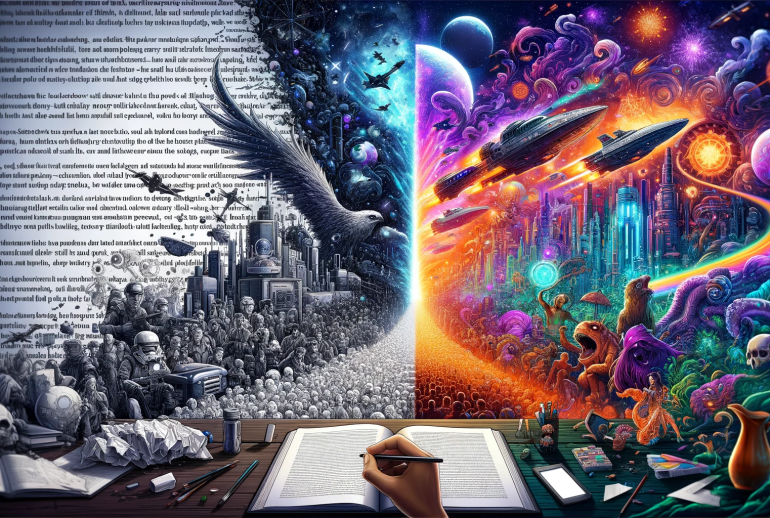In the realm of fiction writing, there’s a golden rule that often separates mediocre storytelling from the truly captivating: “Show, Don’t Tell.” These three words hold immense power, encapsulating a fundamental principle that can transform your writing from bland and passive to vibrant and engaging. In this comprehensive article, we’ll explore the essence of “Show, Don’t Tell,” its importance in storytelling, and practical techniques to master this craft.
The Essence of “Show, Don’t Tell”
At its core, “Show, Don’t Tell” is a storytelling technique that encourages writers to depict scenes, characters, emotions, and actions through vivid and sensory descriptions rather than bluntly stating them. It invites readers to immerse themselves in the story, to feel, see, hear, and experience the narrative as if they were part of it. Let’s break down the essence of this technique:
Engagement: “Show, Don’t Tell” draws readers into the story, allowing them to connect with characters and events on a deeper level. It sparks their imagination, making them active participants rather than passive observers.
Emotion: Instead of simply telling readers how characters feel, “Show, Don’t Tell” evokes emotions through actions, dialogue, and sensory details. Readers experience the emotions alongside the characters, forging a stronger emotional bond.
Imagery: The technique paints vivid mental images, enabling readers to visualize the story’s world, characters, and events. This imagery enhances their understanding and creates a more immersive reading experience.
Inference: By showing, writers allow readers to infer meanings and draw conclusions themselves, fostering a sense of discovery and engagement. It’s a subtler, more sophisticated approach to storytelling.
The Importance of “Show, Don’t Tell”
Why is “Show, Don’t Tell” so crucial in the art of storytelling? Let’s explore its significance:
Reader Engagement: Engaged readers are committed readers. By inviting readers to actively participate in the story, “Show, Don’t Tell” keeps them invested and eager to turn the next page.
Character Depth: Through vivid showing, you can create well-rounded characters with distinct personalities, quirks, and motives. Readers can deduce character traits organically, making the characters more relatable and memorable.
Immersive World-Building: For fantasy, sci-fi, or historical fiction, “Show, Don’t Tell” is indispensable for building immersive worlds. It allows you to describe settings, cultures, and atmospheres in ways that transport readers to new realms.
Emotional Impact: Emotions conveyed through actions, expressions, and reactions resonate more deeply with readers. This emotional connection is the heart of compelling storytelling.
Showcasing Skills: Effective use of “Show, Don’t Tell” demonstrates your writing prowess. It showcases your ability to paint pictures with words and create narratives that leave a lasting impression.
Practical Techniques to Master “Show, Don’t Tell”
Now that we understand the essence and importance of “Show, Don’t Tell,” let’s delve into practical techniques to master this craft:
1. Use Sensory Details:
Engage the Senses: Appeal to readers’ senses by describing sights, sounds, smells, tastes, and textures. This immerses readers in the story and makes it more vivid.
Example: Instead of saying, “It was a hot summer day,” describe the sweltering heat: “The sun scorched the asphalt, and waves of heat shimmered above the pavement.”
2. Show Character Emotions Through Actions:
Actions Speak Louder: Instead of stating emotions outright, show them through characters’ actions, body language, and facial expressions.
Example: Instead of saying, “She was nervous,” show her fidgeting with her pen, biting her lip, and avoiding eye contact.
3. Use Dialogue Effectively:
Subtext in Dialogue: Infuse subtext into conversations, allowing characters to express themselves indirectly. Let readers decipher the unspoken tensions and motivations.
Example: Instead of saying, “He was angry,” show it through dialogue: “Why can’t you ever be on time?” he snapped.
4. Employ Metaphors and Similes:
Comparative Imagery: Use metaphors and similes to draw comparisons that evoke vivid images and emotions.
Example: Instead of saying, “The night was quiet,” use a metaphor: “The night wrapped around them like a velvet curtain, muffling every sound.”
5. Reveal Backstory Gradually:
Flashbacks and Memories: Instead of lengthy exposition, reveal a character’s backstory through snippets, memories, and reflective moments.
Example: Rather than a backstory dump, show it through a character’s haunted gaze at an old photograph.
6. Let Characters Make Inferences:
Allow Readers to Connect Dots: Instead of explicitly explaining every detail, let readers make inferences and connect dots themselves.
Example: Instead of saying, “She suspected he was lying,” show her narrowing her eyes and furrowing her brow.
7. Vary the Pace:
Show vs. Tell Balance: Find a balance between showing and telling. Use showing for pivotal scenes and telling for transitional or less significant moments.
Example: Use showing to convey the climactic confrontation between characters and telling for routine actions like getting dressed.
8. Edit Ruthlessly:
Trim Unnecessary Telling: During the editing process, identify instances of unnecessary telling and replace them with showing.
Example: Instead of saying, “He felt exhilarated,” ask whether the context and actions already convey this feeling.
Conclusion: The Magic of “Show, Don’t Tell”
“Show, Don’t Tell” is the magic wand of storytelling. It transforms words on a page into living, breathing experiences for readers. By mastering this technique, you can captivate your audience, create memorable characters, and craft narratives that linger long after the book is closed. Embrace the art of showing, and watch your stories come to life in ways you never thought possible.



